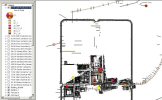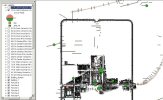Cloth-production activities include spinning, weaving and sewing. As one might expect, few such items are found at Vetera I, although cloth-production items do exist at a number of military sites. Indeed, no items found at Vetera I can be definitively associated with clothworking but a handful is possibly associated. These include a pair of iron shears, clay weights, a bone disc and remains of bone pins, and bronze needles and/or pins.
The shears were most probably used for shearing sheep or cutting cloth (see Manning 1985, pl.14 D4-D6; see also White 1967, 119-120; Gaitzsch 1980, 213-16), although it has also been suggested that they could have been for other purposes such as trimming horse's coats or cutting the grass on the ramparts (Frere and Wilkes 1989, 161; no. 128). The clay weights could have been used for weaving. K21 is not the usual pyramid-shape for a loom-weight but has two holes which suggest that it could have been suspended as a loom-weight. The bone disc and some of the bone pins could have been the remains of spindles and spindle whorls. Wild's study of spindles from the northern provinces (1970a, 32-35), and my own observations on spindle whorls and bone discs from the Insula del Menandro in Pompeii (Allison n.d. 1), indicate that discs, with a diameter of c. 35-50 mm, a central hole of c. 6-9 mm in diameter and made of pottery, stone, lead or bone, were likely to have been spindle whorls. J8 is comparable, if a little on the small side. According to Wild (1970a, 32-33) spindles were made of bone or wood, thickened near the lower end to hold the spindle. They could be up to 300 mm in length but those in the northern provinces were commonly 120-250 mm, with bulbs c. 10 mm in diameter. The recorded remains of bone pins (J1-J2, J5-J7), could conceivably have been parts of such spindles. The complete and fragmentary bronze pins could have been used for sewing or toilet activities or were parts of hairpins.
Modern scholars generally view the processing of household cloth in the Roman world as a female activity, but when cloth production is identified as a commercial activity it is assumed to have been carried out by men (Dixon 2001, 117-29). However, as argued by Dixon (2001, 121-22), such a 'female/domestic and male/commercial' dichotomy relies heavily on analogies of post-industrial separations of public and private life (see also Dixon 2000-2001). Indeed, weaving seems to be a particularly androgynous activity in the Roman world, involving both male and female weavers in courtyard workshops, high-status houses and family businesses, although in general women seem to predominate in the working of wool (Treggiari 1976, 81-85). The procedures for weaving within a military context are not well understood. At Vindolanda there seems to be evidence for weaving, and possibly spinning, in that wool was purchased (Bowman 1994, 72, 118 no. 12, 120 no. 14; Bowman and Thomas 1994, nos 192 and 196). Weaving is, therefore, classified as 'male?/female?' here.
Spinning would seem to be more securely identified as a female activity (e.g. Deschler-Erb 1998, 136-37; Treggiari 1976, 82). Spinning implements are symbols often associated with women, and particularly brides (Dixon 2001, 117-18). They are therefore classified as 'female?' items here. However, as the remains of bone pins could alternatively have been parts of styli (see Section 8.5) or hairpins, these have been categorised as 'male?/female?'.
As noted in Section 8.1.2 needles may have been used for surgery as well as for sewing. Also, Allason-Jones has argued (1995, 28) from their presence in the turrets on Hadrian's Wall, that these items were used by men as well as by women, soldiers needing to do their own mending. Therefore needles and fragmentary remains of either bronze needles or pins are also categorised as 'male?/female?'.
There are no items that are unequivocally categorised as cloth-working equipment from Vetera I. Besides the obvious explanation that cloth-working was not an activity expected to have been carried out within a military site, there are a number of other possible alternative explanations for this. One of the main reasons is likely to be because most of the bone items from Vetera I were not included in Hanel's artefact catalogue as these are currently being studied. Although Hanel could detect no hint of this (pers. comm.), there may also have been a process, whether conscious or unconscious, to pay less attention to items which provide little chronological information and which should not have been found with a military context, such as identifiable loom-weights. However, loom-weights, weaving hooks and spindle whorls have been found within other forts and fortresses (e.g. Ellingen - Zanier 1992, nos B150, D2-D3, EII1701-1705; Carnuntum - Grünewald 1981, esp. pl. 8 no 4, 1986, pl. 11 nos 1-4).
Following a review of legacy systems and in line with broader ADS practice, the interactive map element of this article has been decommissioned. The full underlying set of data is still available for download from the digital archive.

Screendump of ArcGIS query - (C1), cloth-working items
Only fourteen items could possibly have been used for cloth-working. These include remains of pair of shears (ZC), bronze needles (ZC_T), clay weights (ZC_WM), a bone disc (ZD_C_F_G), remains of bronze pins or needles (ZD_C_T), and remains of bone pins or needles (ZD_C_W). Two such items are from outside the Claudian-Neronian fortress and three, in the vicinity Building G, were probably in pre-Claudian contexts (Trench 325, pits 1and 2). Of the remaining nine items, three were found inside and immediately in front of Building A, two in the central open area, one in barracks V, one in Building Z, one to the north of barracks Y, and one in Building S. Two found within Building A are likely to have been writing implements see Section 8.5. More interesting is the item found in Building Z, which was a dress, furniture or gaming item if it was not a cloth-working implement.

Screendump of ArcGIS query - (C2), cloth-working items - women?
Because most of these items have been gendered male?/female?, their distribution is uninformative about the presence of women. However, the bone disc found in Building Z is gendered 'female?' and, again, presents an interesting perspective on the identification on this building.
© Internet Archaeology
URL: http://intarch.ac.uk/journal/issue17/4/8.3.html
Last updated: Mon Apr 4 2005